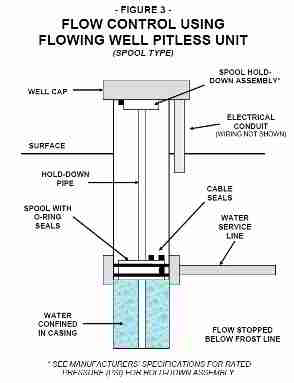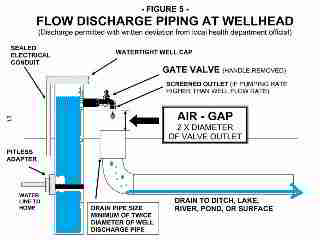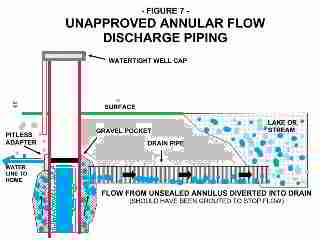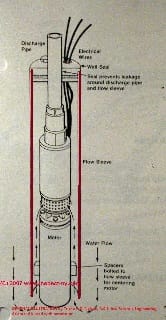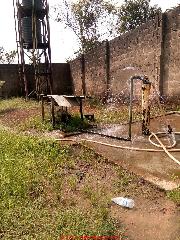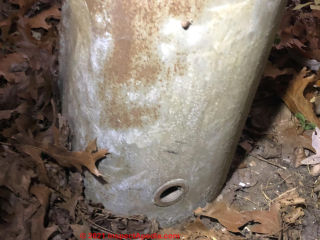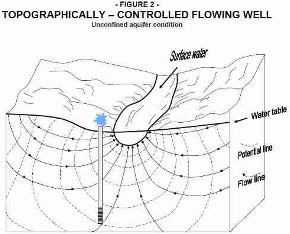 Flowing Artesian Wells
Flowing Artesian Wells
Construction, Flow Rates, Pressures, Troubleshooting, Repairs
- POST a QUESTION or COMMENT about artesian wells: construction, troubleshooting, repair
Artesian well construction & repair:
This article describes the construction of artesian water wells.
We describe types of artesian wells, how water flow from the artesian well is controlled, special artesian well parts like the well spool, and we discuss special problems for artesian wells and the property around them when there is a leak in the well casing.
InspectAPedia tolerates no conflicts of interest. We have no relationship with advertisers, products, or services discussed at this website.
- Daniel Friedman, Publisher/Editor/Author - See WHO ARE WE?
Construction of Flowing Artesian Wells
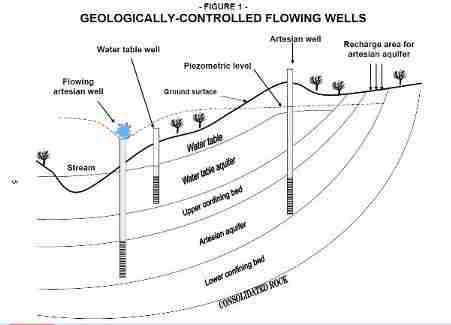 Our page top sketch, courtesy Michigan DEP, illustrates a topographically-controlled flowing artesian well.
Our page top sketch, courtesy Michigan DEP, illustrates a topographically-controlled flowing artesian well.
Our sketch at left explains how an artesian well is formed, and introduces the proper term "Geologically-controlled flowing wells".
[Click to enlarge any image]
In a geologically-controlled flowing well, [image] water is sent to the top of the well casing by pressures formed in the underlying geological structure of the earth.
In a topographically-controlled flowing artesian well, [image] pressure that pushes water to the top of the well casing is developed by surrounding land and/water that create water pressure in the well that is higher than the surrounding land pressure.
Sketch courtesy Michigan DEP.[8] - Ed.
The flow rate of water delivered by an artesian well varies from very high and capable of serving multiple homes or families, and so weak as to require ancillary storage or supplemental pumping. The Michigan DEP artesian well document cited at the end of this page reports two two-inch diameter artesian wells in Michigan flowing at a rate of over 450 gpm (Leverett 1907) and at "shut-in" pressures of 30 psi.
Definition of Flowing Artesian Well
Definition of artesian well: Any well in which water pressure from the aquifer causes water to rise in the well bore to a height above the top of the aquifer is considered an artesian well.
However not all artesian wells are considered flowing artesian wells. Water in an artesian well may rise above the height of the source aquifer but may still not rise up above the ground surface. That's an artesian well but not a flowing artesian well.
Definition of flowing artesian well: A well in which water pressure from the aquifer causes water to rise in the well bore to a height above the surrounding ground surface is considered a flowing artesian well.
Causes of Variation in the Water Level or Flow Rate of Artesian Wells
The height of water above the aquifer in an artesian well or the height to which water would rise above surrounding ground level in a flowing artesian well varies over time because of a number of factors including:
- Aquifer recharge events:
rain, melting snow, or other sources of water that re-charge the supplying underground aquifer after water has been withdrawn (through the artesian well) - Aquifer size and aquifer head:
larger aquifers in a topography giving higher head pressure will produce greater flow rates. - Damage to the aquifer or to the well casing:
leaks around casings sunk into the artesian well aquifer will reduce the flow rate delivered by the well. - Elevation:
actual elevation of the ground surface or top of artesian well casing above the aquifer top - a condition that varies across terrain - Location of the well tap:
the actual location of the well tap in the aquifer will affect its flow rate. Keep in mind that contrary to our intuition, the shape, depth, and pressures of the supplying water aquifer underground varies and is rarely dead flat.
Only wells whose bottom tap into the aquifer is deep enough to intercept a zone in the aquifer where the aquifer's head pressure or hydraulic head is greater than the surrounding land surface will the aquifer deliver a flowing artesian well. - Weather conditions:
lower barometric pressure will permit water to rise higher above the supplying aquifer at an artesian or flowing artesian well. - Withdrawal or Pumping rates:
the rate at which water is being removed from the aquifer by wells that it serves. Artesian well experts may refer to withdrawal or pumping rates as the artesian well loading factor.
Well spools & artesian well casing leak repair using well sleeves
Our water pump in the well recently went out and we hired a crew to replace the pump. However I am concerned if he used correct procedure and if caused more problems than we started with.
When he first started pulling up the drop pipe the "spool" was stuck and he had problems with pulling it up at first, once it came free he set it back down and took the cable off.
Then he came up to the house and told me he is going to pour some acid down to soak over night and loosen up the "spool" so he could pull it up, he dumped about 2 gallons of it down there and the next day he pulled everything up again.
Later when he started blasting out the black water a bunch of sand came out and he told us we need an entirely new well because there is a hole in the case, and sleeving the case wasn't an option. However after he left I was looking at the pipes and wire left that was pulled up and they have some bad corrosion just above the water level.
I am wondering if the acid he poured down the casing ate through the casing where it sat overnight and caused the hole? Also there was no sand to be found in the old pump which makes me more suspicious.
What is a Well Spool, Why a Well Spool may be Needed, How they are Installed on Artesian Wells
 Your description of "a bunch of sand came out..." may indeed be the first indicator that a homeowner sees pointing to a hole or crack in the well casing of an artesian well.
Your description of "a bunch of sand came out..." may indeed be the first indicator that a homeowner sees pointing to a hole or crack in the well casing of an artesian well.
Below we describe well spools used for flowing artesian wells and possibly in other wells with a very high-rising static head.
We discuss the repair options for a cracked or leaky well casing separately
at WELL CASING LEAK REPAIRS.
Our illustration of a well spool at left, edited from a schematic provided by Baker Manufacturing[7] illustrates the part of this assembly - you can see why it's called a "spool" - it looks like one.
Baker Manufacturing produces and sells well spools and pitless adapters for 4", 5" and 6" diameter well casings and water wells.
The well spool is held in position by a hold-down spider [purple assembly at image top] and set screws to keep the spool from being pushed up in the casing by the pressure of water rising in the well casing, and O-rings seal the well spool to the well casing itself. [7] - Ed. [Illustration adapted from & permission & tech review requested 6/27/12]
Reader follow-up - questions about proposed artesian well repair
Is this acid treatment normal and safe for the casing?
Is he telling me the truth that no one ever "sleeves" the case and that its not an option?
Thank you ahead of time for any information about this, I am not made of money and can't afford to be taken advantage of. Thanks again - B.T. 4/25/12
Reply: Description of well casing repair sleeves to repair well casing leaks at residential water wells
A competent onsite inspection by an expert usually finds additional clues that help accurately diagnose a problem, and I'm not at all sure I have a full picture of what's going on with your well.
That said, here are some things to consider about well spools, leaks in the well casing, and using acid to free up a stuck well spool in your well. Regarding your well driller's use of acid to free up a stuck well spool, our OPINION is that like you, dumping any potentially toxic or harmful chemical into a well makes us very nervous.
OPINION: when you are not comfortable with advice you've received about how your well should be repaired ("you need a new well"), start by asking your well driller to explain his reasoning in a little more detail.
Most contractors are quite honest and are not out to gouge you, but they were not English majors and may not be expert in communication.
Watch out: in general, trying to stop or even just slow down the flow from older flowing artesian wells risks burst pipes, un-controlled leaks, and in some cases potentially dangerous bursting of water tanks or equipment that could injure someone nearby.
Types of well spools used to keep artesian wells from overflowing in freezing & non-freezing climates
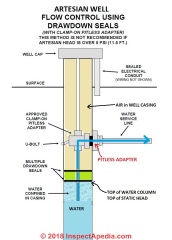
Well Spool Installation Using Clamp-on Pitless Adapter
A well spool is a special seal around the well piping used to seal a well casing in wells at which the static head of water level in the well casing rises above the frost level.
Basically it's a "spool-shaped" plumbing fitting that incorporates round flanges at its top and bottom, threaded to accept well pipe fittings above and below the spool.
Well spools are required on artesian wells or "flowing wells" in freezing climates.[8] Without this component the upper well casing could be split by freezing water.
Our illustration (left) shows a low-pressure well spool using a clamp-on pitless adapter in a design suitable for artesian wells whose head pressure is equal to or less than 5 psi (a head of 11.5 ft.) - courtesy Michigan DEP.
Speaking with more precision, an artesian well is one in which water rises in the well casing high enough to deliver water to a building, and higher than the local groundwater table, due to water pressure within the drinking water aquifer, but stopping below the top of the well casing itself.
A "flowing artesian well" is one in which pressure from within the aquifer will, left alone, actually push water right up the well casing and out of its top.
Well Spool Installation for low-pressure artesian wells & non-freezing climates
Our illustration of a low-pressure well spool at above left is provided by the Michigan DEP Flowing Well Handbook and [8] illustrates the part of this assembly more clearly than our earlier sketch.
Unlike the Baker well spool shown earlier, this version shows the well spool being held down by an assembly accessed just under the well cap and installed quite near the top of the well - a design suitable only for non-freezing climates or for a well cap that is located below grade in a well pit where it is protected from frost. [Permission & tech review requested 6/27/12]
If your well incorporates a well spool that means that left alone water would rise in the well casing above the frost level in your area, risking well damage. And if the well spool becomes stuck, special methods may be needed to loosen it before the well piping and pump can be pulled from the well.
In non-freezing climates the well spool is not needed; instead the well installer relies on the well cap installed at the top of the well casing to keep the artesian well from overflowing.
Other Methods for Controlling Water Flow From Artesian Wells
An alternative to using a well spool to "cap" or withstand the pressure within an artesian well involves using any of several methods to first provide sufficient water pressure to supply the building and second a method to allow excess water to drain to an approved location.
Approved Artesian Well excess water discharge methods
Above: large diameter drain used to carry flowing artesian well excess discharge to a safe surface location. The drain line is taken to a location that avoids problematic wet or soggy areas around the well.
Watch out: the note in the illustration suggesting "DRAIN TO DITCH LAKE RIVER POND OR SURFACE" is correct but needs to be understood to include the air gap shown in the illustration. Never pipe a hard-connected flowing artesian well drain line from the well to beneath the surface of a ditch, lake, river, or pond.
Making that mistake, technically a cross-connection, risks back-contamination of the artesian well water during periods when the artesian well's own supply pressure falls or stops temporarily.
Special additional measures may be needed to protect flowing artesian well overflow discharge from freezing at the well, where ice or frost can also damage well or piping components.
See details
at ARTESIAN WELL FREEZE PROTECTION
- Gate valve installed near top of an above-ground well casing. The gate valve is designed to drain off excessive pressure or flow from an artesian well casing or bore.
Excess flow from the well casing can be occasionally drained, using a gate valve (normally left with handle removed) and a screened outlet to protect against drawing contaminants in through the faucet mouth; the faucet gate valve drains through air (an air gap, hence no cross connection risk) into a buried drain line that conducts excess water to a ditch, river, pond, or the surface.
This excess artesian well flow discharge is permitted with written permission from a local health department official and is not expected to be constant.
Illustrations adapted from: Michigan DEP Flowing Well Handbook [8]

- Elevated water storage tank: water from the artesian well feeds a non-pressurized water storage tank.
A drain line exiting from the top of the water storage tank passes a gate valve used to control the flow rate out of the discharge line and then through a discharge tube that spills the drainage water across an air gap (hence no unsanitary cross connection) to a drain line that removes excess water to an acceptable destination.
The receiving flow drain line must be at least 2x the diameter of the storage tank discharge tube.
In this artesian well control design, a one line jet pump or equivalent is used to move water from the non-pressurized water storage tank into a water pressure tank that in turn delivers water to the building plumbing system at sufficient pressure (typically 20-40 or 30-50 psi).
Illustration source: Michigan DEP Flowing Well Handbook [8]
Unapproved Artesian Well excess water discharge methods
- LEAKAGE around the well casing [Image file]
draining by diversion pipe to a lake or stream. Leaks around the well casing should be repaired by grouting the casing - a step that can be a challenge in high-flow high-pressure artesian wells.
Allowing a leak around the well casing to continue wastes water and risks cross-contamination of the aquifer during periods of change in water flow and pressure.
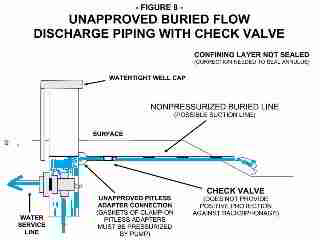
- Buried artesian well overflow pipe with check valve.
Figure 8 at above left (Illustration adapted from: Michigan DEP Flowing Well Handbook [8]) illustrates several defects in this approach to well flow control:
the confining layer is not sealed, the check valve in the discharge line is not an approved protection against a cross-connection or back flow that risks contaminating the aquifer, and the sketch shows an improper pitless adapter installation that is not pressurized. - SUBMERGED INLET [and outlet] drainage pipe [image]
from the artesian well casing: using a non-pressurized buried line connected directly to the well casing above the pitless adapter as a means to control the maximum static water head height in the well casing - water drawn from the casing is discharged to a lake or stream.
The risk is that under changing conditions in the aquifer and inside the artesian well, water can flow backwards from the lake or stream, forming a cross connection and back-contaminating the aquifer.
Problems with Leaks in the Steel Casing of an Artesian Well
Leaks in the well casing are a problem because of the risk of leaks of surface contaminants into the well.
Our sketch at far left crams more parts into a small space than you'd find in a real water well - we've got the submersible pump up there near the top of the well casing;
actually the pump will be located a few feet or more off of the well bottom, and actually in most water wells the steel casing extends from the ground surface down into bedrock but the well bore itself continues down through that rock to a deeper depth - the casing does not extend to the very bottom of the well. - Ed.
The Michigan DEP sketch above (figure 7) illustrates an improper means of getting rid of water leaking around the well casing of an artesian well. Illustration adapted from: Michigan DEP Flowing Well Handbook [8]
As the Michigan DEP points out,
Sealing the annular space surrounding the well casing is critical, since an ineffective seal or absence of a seal can result in the uncontrolled discharge of water on the outside of the well casing pipe.
When ground water breaks out on the outside of the well casing, erosion of the confining geologic layer and other overlying materials can occur.
The uncontrolled discharge of ground water from flowing wells can cause flooding of the well site and adjacent properties and damage to nearby structures. [8]
We discuss the repair options for a cracked or leaky well casing separately and in detail
Question: water runs rapidly out of our well bore, how do we stop it?
2019/01/14 ajayi said:
Please how do I stop a borehole with jet pumping machine that water is continuously flowing out from it even when the machine is not powered ON?
Kindly find the attached image.
[Click to enlarge any image]
This question and reply were posted originally
Reply:
Watch out: if the power to your pump is off and water continues to flow out of the borehole, trying to stop the flow can cause more damage to the well.
I suspect that changes in local conditions of the aquifer into which your borehole well is tapped have caused a (probably) temporary flowing artesian well condition.
See details on controlling artesian wells throughout this article and in the reference documents just below where you will find a discussion of ways to control excess water from such a well.
I doubt that you want to abandon your well but for other readers for whom that is a consideration we add
Artesian wells, free-flowing artesian wells, and gravel pack wells can present special abandonment problems. Often States have specific standards for abandoning these kinds of wells. If the State does not have such standards, the system should seek advice from an engineer, well driller, hydrologist, or other professional. - (EPA 2008)
Flowing Artesian Well Design, Control, Repair References
- Alabama DEQ, GROUND WATER CONTAMINATION [PDF] Alabama Department of State, retrieved 2019/01/14 original source: http://www.adem.state.al.us/MoreInfo/pubs/GWpart2.pdf
- Aller, Linda, Truman W. Bennett, Glen Hackett, Rebvecca J. Petty, Jay H. Lehr, Helen Sedoris, David M. Nielsen, Jane E. Denne, HANDBOOK of SUGGESTED PRACTICES for the DESIGN and INSTALLATION of GROUND WATER MONITORING WELLS [PDF] (1991), EPA160014-8910345 Environmental Monitoring Systems Laboratory
Office of Research and Development U.S. Environmental Protection Agency Las Vegas, Nevada 89193-3478
Excerpt:
Procedures for Abandonment Without Casing Removal — Using Plugs — If artesian conditions are encountered, several techniques can be used to abandon the well.
To effectively plug an artesian well, flow must be stopped and the water level lowered during seal emplacement.
The water level can be lowered by: 1) drawing down the well by pumping nearby wells, 2) placing fluids of high specific gravity in the borehole or 3) elevating the casing high enough to stop the flow (Driscoll, 1986).
If the rate of flow is high, neat cement or sand/cement grout can be piped under pressure, or a packer can be located at the bottom of the confining formation above the production zone (United States Environmental Protection Agency, 1975).
Fast-setting cement can sometimes be used in sealing artesian wells (Herndon and Smith, 1984). - ARTESIAN WELL FREEZE PROTECTION web article
- [10] ASTM D 5299-92, Standard for Decommissioning of Ground Water Wells, Vadose Zone Monitoring Devices, Boreholes, and Other Devices for Environmental Activities, 1993, American Society for Testing Materials, West Conshohocken, Pennsylvania.
- BC GWA, Flowing Artesian Water Well Control Methods (2015), British Columbia Ground Water Association, 1334 Riverside Road, Abbotsford British Columbia V2S-8J2 Canada secretary@bcgwa.org 604-530-8934 general-manager@bcgwa.org 604-362-5132 Web article retrieved 2019/01/14, original source: https://www.bcgwa.org/flowing-artesian-water-well-control-methods/ [copy on file]
- BC, FLOWING ARTESIAN WELLS [PDF] British Columbia Ministry of Environment,, retrieved 2019/02/13 original source: http://www.env.gov.bc.ca/wsd/plan_protect_sustain/groundwater/flowing_artesian_wells.pdf
This document also offers
A registry of qualified well drillers can be found at: http://www.env.gov.bc.ca/wsd/plan_protect_sustain/ groundwater/wells/applications/well_drillers_reg.pdf.
A listing of groundwater consultants (qualified professionals) can be found at: http://www.env.gov.bc.ca/wsd/plan_protect_ sustain/groundwater/library/consultants.html. - Buckland, William. Geology and mineralogy considered with reference to natural theology. No. 6. G. Routledge & Company, 1858.
Buckland notes: In the Tertiary basin of the Perpignan and the chalk of Tours, there are almost subterranean rivers having enormous upward pressure. The Water of an Artesian well in Roussillon rises from 30 to 50 feet above the surface.
At Perpignan and Tours, M. Arago states that the water rushes up with so much force that a Cannon Ball palced in the Pipe of an Artesian Well is violently ejected by the ascending stream. - Op. Cit. p. 423. - Canada, FLOWING WELL CONSTRUCTION, BEST PRACTICES [PDF] Chapter 12 excerpted from this complete document
WATER SUPPLY WELLS BEST PRACTICES [PDF], Ministry of the Environment, Conservation and Parks, Website: https://www.ontario.ca Tel: 416-325-4000 / Toll-free: 1-800-565-4923 retrieved 2019/02/14 original source: https://www.ontario.ca/document/water-supply-wells-requirements-and-best-practices/flowing-wells
Excerpt: This chapter describes flowing wells footnote 1 [1] and how to predict the likelihood of encountering a flowing well.
This chapter also discusses how to address flowing conditions when a well is constructed.
Due to the serious consequences, such as flooding and property destruction that can result from uncontrolled flowing wells, additional resources including experienced professionals and publications should be consulted if flowing conditions are likely to be encountered.
- Cotecchia, V., G. D'Ecclesiis, and M. Polemio. "High pressure artesian wells to tap Torbido spring (Italy)." In Environmental Management Geo-Water and Engineering Aspects. Balkema, 1993.
- Haman, Dorota Z., Allen G. Smajstrla, and Gary A. Clark. Water wells for Florida irrigation systems. University of Florida Cooperative Extension Service, Institute of Food and Agriculture Sciences, EDIS, 1988.
- [8] MI DEQ, FLOWING WELL CONSTRUCTION HANDBOOK [PDF] (2005) Michigan Department of Water Environmental Quality Water Bureau (DEQ), Drinking Water & Environmental Health Section, Well Construction Unit,web search 6/27/12, original source: http://www.michigan.gov/documents/deq/deq-wb-dwehs-wcu-flowwellhandbook_221323_7.pdf
- MI DEQ, PROBLEM WELLS - Flowing Artesian Well Control, [PDF] Michigan DEQ, retrieved 2019/01/14, original source: https://www.michigan.gov/documents/deq/deq-wb-dwehs-gwwfwim-section16_183043_7.pdf
- NH DES, BEDROCK ARTESIAN WELL DESIGN [PDF] New Hampshire Department of Environmental Services, retrieved 20198/02/13 original source: https://www.des.nh.gov/organization/commissioner/pip/factsheets/dwgb/documents/dwgb-1-2.pdf
- US EPA, MANUAL of WATER WELL CONSTRUCTION PRACTICES [PDF] EPA 570/9-75-001, retrieved 2019/01/14, original source: https://nepis.epa.gov/Exe/ZyPDF.cgi/2000J6P4.PDF?Dockey=2000J6P4.PDF
- US EPA, GROUND WATER RULE CORRECTIVE ACTIONS GUIDANCE MANUAL [PDF] U.S. Epa, retrieved 2019/01/14, original source: https://www.env.nm.gov/dwb/regulations/documents/guide_gwr_correctiveaction.pdf
- USGS ARTESIAN WATER and ARTESIAN WELLS [PDF] U.S.G.S. United States Geological Survey, Water Science School, retrieved 2021/11/11 original source: https://www.usgs.gov/special-topic/water-science-school/science/artesian-water-and-artesian-wells?qt-science_center_objects=0#qt-science_center_objects
- [9] W. B. Allen, Flowing Wells in Michigan, 1974 U. S. Geological Survey, Water Information Series Report 2
- Wellbusters, Flowing Well Packer, Wellbusters Co., Ontario, Canada, Tel: 1.866.968.1474 Fax: 1.613.968.1477 Email: info@wellbusters.com, to vent artesian wells while preventing artesian well overflow freeze damage, retrieved 2019/02/13 original source: http://www.wellbusters.com/?page_id=159 - details are
at ARTESIAN WELL FREEZE PROTECTION - Also see more citations atReferences or Citations below
...
Reader Comments, Questions & Answers About The Article Above
Below you will find questions and answers previously posted on this page at its page bottom reader comment box.
Reader Q&A - also see RECOMMENDED ARTICLES & FAQs
On 2021-11-19 by Inspectapedia Com Moderator (mod) - possible abandoned flowing artesian well
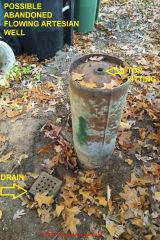 @nate,
@nate,
No but IF your well was a "flowing artesian well" and water flowed out of the well top or out of a drain opening then the installer might have installed a nearby drain to carry off that excess water .
From the appearance of the casing and the fact that it seems to have a welded top seal with a fitting for a pipe, one might guess that this was previously a flowing artesian well whose water flow stopped or "went dry".
On 2021-11-19 by nate - explain presence of a drain next to a well casing
@Inspectapedia Com Moderator, thanks for your response. Does every deep water well have a drain next to it?
On 2021-11-19 by Inspectapedia Com Moderator (mod)
@nate,
Looks like an abandoned well.
That top hole could have been a water pipe connection to a flowing artesian well, OR if there was actually a pump in the well it may have been a flowing artesian well whose flow was intermittent and ultimately needed a pump, later was abandoned completely if the well's flow and recovery rate fell below a useful level.
On 2021-11-19 by nate - what is the steel casing in my back yard - an old well?
And a hole towards the bottom. Sorry for all the posts
It also has a hole on top. it possibly has an electric wire running inside
Hi. I have this in the backyard its sticking out about 3 feet from the ground with a diameter of about 1 foot or so. There is also a drain right next to it. Can you help out?
This Q&A were posted originally
at OLD WELL - RETURN TO SERVICE
Question: what is the dynamic head pressure produced by a flowing artesian well?
How much psi is in an 8" artesian well at 600ft depth? - Thomas Leonard
This question was posted originally
at WELL DYNAMIC HEAD & STATIC HEAD DEFINITION
Moderator reply: what would be the water pressure produced by your artesian well ?
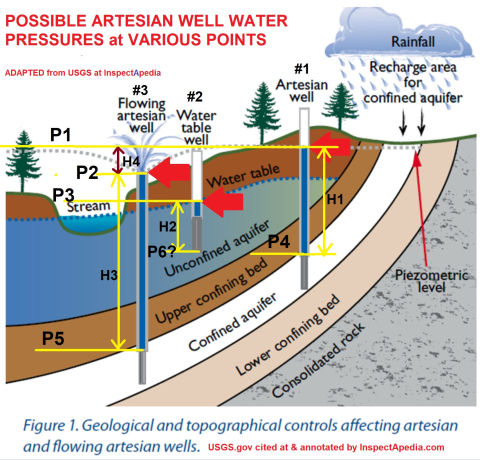 You would have found the start of the answer to your question given in the article above on this page from which I excerpt
You would have found the start of the answer to your question given in the article above on this page from which I excerpt
Static head pressure: The PSI of water pressure at the base of a column of water of height H in feet = H x 0.433 psi
I'm sure you could do that math.
However, when you add that yours is an Artesian well, no one can answer your question because we don't have the necessary data.
If your well is an artesian well but not a flowing artesian well, it has no dynamic head pressure, just static head pressure.
If your well is a flowing artesian well we would still need to know the elevations of the piezometric level of the confined water aquifer and the of the top of your well casing.
Measuring the pressure is an easier and less-theoretical solution. But we will review the calculations here.
In the case of an artesian well. we can't simply calculate the static head pressure at the well bottom using the formula above. because the aquifer itself is providing water at pressure sufficient to send water up and out of the well casing if the casing were open at the top.
Or to pressurize a closed casing until it reaches the actual delivery pressure of the surrounding aquifer.
Details:
Consider that by definition an artesian well is one in which water is forced into the well casing by the greater pressure of the surrounding aquifer, sufficient that water will even rise to the top of the casing and would flow out of the well, hence the term flowing Artesian well.
[Click to enlarge any image]
There would be different pressures that one could detect depending on whether the well is open at the top so that water can flow out or whether the well is in fact correctly constructed and sealed with a well spool to retain water in the well casing.
If the latter describes your artesian. well then the pressure produced in that well is specific to the aquifer that feeds it, and unfortunately there's not therefore a single right answer.
Furthermore if your well is like most artesian wells, the actual pressure provided by the surrounding aquifer varies seasonally and by weather, barometric pressure, and other features.
It would in fact be quite interesting for you to simply install a pressure gauge on the well sensing pressure below the well spool or at ground level teed off of the water pipe where it exits the well.
That would allow you to monitor the pressure.
Theoretical pressures of an artesian well
Let's offer several different measurements of artesian well water pressure, using a USGS illustration of artesian wells to which we add a few annotations. The USGS source for this nice drawing is
- USGS ARTESIAN WATER and ARTESIAN WELLS [PDF] U.S.G.S. United States Geological Survey, Water Science School
Artesian well pressure at the well top - artesian well delivery pressure
This is the more-interesting water pressure if we are in fact taking water out of the artesian well at the well casing top, as it's the artesian well's "delivery pressure" (our term).
Even here there are more than one possible water pressure situations. Refer to the well numbers and pressure numbers annotated on to the USGS illustration shown here.
...
| Water Pressures at Wells | ||
| Water Pressure | ||
| Well # | Well Top or Water Top |
Well Bottom |
| Well #1 - Artesian | P1 = 0 psi = Piezometric level |
P4 = Static head H1 x 0.433 psi |
| Well #2 - Water-Table | P3 = 0 PSI | P6 = Static head H2 x 0.433 psi |
| Well #3 - Flowing Artesian | P2 = H4 x 0.433 psi = delivery pressure |
P5 = Static head H3 x 0.433 psi |
Notes to the table above
- Definition of potentiometric surface pressure of an artesian well:
For groundwater "potentiometric surface" is a synonym of "piezometric surface" which is an imaginary surface that defines the level to which water in a confined aquifer would rise were it completely pierced with wells. ... Contour maps and profiles of the potentiometric surface can be prepared from the well data. - Wikipedia 2021/11/11
- Well #1 Pressures: non-flowing artesian well
This artesian well is not a "flowing" well. Water rises in the casing to the point shown but does not flow up out of the top of the casing on its own.
Water pressure at the top of the water column or static head of Well #1 = 0 psi = the Piezometric level
If we eschew for now variations in the pressure offered by the artesian well's aquifer or water source over time we can claim that the pressure produced by an artesian well IF the top of your well were at the identical elevation as the top of the artesian well aquifer would be 0 psi at the well top
Water pressure at the bottom of the static head of Well #1 = P4 = Static head H1 x 0.433 psi - Well #2 Pressures: water table well
This is not an artesian well, it is tapping water into an unconfined aquifer whose water rises to the height H2 in the well casing as shown in the illustration.
At the top of this water column the water pressure is 0 psi
Water pressure at the bottom of the static head of Well #2 = P6 = Static head H2 x 0.433 psi - Well #3 Pressures: flowing artesian well dynamic head or delivery pressure
This is a flowing artesian well because if the casing top is left open water will flow out of the casing top, pushed by the pressure in the confined aquifer (white in the illustration)
At the top of Well #3, IF we closed the top of the well, the delivery pressure of the well (P2) can be estimated by noting H4, the difference between the actual elevation of the top of the well and the elevation of the piezometric level of the confined aquifer.
P2 = H4 x 0.433 psi
And at the bottom of this well we think that the water pressure would be the sum of the static head pressure P5 + P2 the delivery pressure or the well's dynamic head
So what would be the water pressure produced by flowing artesian well if the well were capped to stop water from simply exiting at the well top?
We don't know because we don't know the elevation of the piezometric level of the confined aquifer that feeds his well, and we don't know the elevation above sea level of the top of his well casing.
What's left to do? Measure the actual delivery pressure of the well - that's what the Wise Lady from Philadelphia advises.
Question: How to Calculate TDH Total Dynamic Head for a flowing artesian water well
2021/02/05 Zakaria Hofra said:
We have a new flowing artesian well, and we want to size the perfect pump for it.
What is the perfect pump (submersible or centrifugal) kind for it?
What is the best depth to install the pump?
How to calculate total dynamic head of the system in such case?
This Q&A were posted originally
at PUMP, SUBMERSIBLE OPERATION
Moderator reply: example calcuation of total dynamic head for a flowing artesian water well
Zak
Thank you for the artesian well questions including the calculation of TDH total dynamic head.
You will see that without knowing specifics of your well such as its bore depth and the height of its water column, nobody can tell you its TDH or Total Dynamic Head.
But please take a look at
TOTAL DYNAMIC HEAD where we explain TDH, repeat your question, and give a very detailed reply.
What pump to buy? The answer depends on the total lift needed or elevation difference between the well casing top and the point of use in the building. A 1 line jet pump can lift about 27 ft. For a building much higher than the well casing top you may need a 2 line jet pump or a booster pump and tank.
A jet pump is installed above-ground. A submersible pump, if that were really needed, could be well above the well bottom but we cannot guess the right answer until the owner finds out (from nearby flowing artesian well owners tapped into the same confined aquifer) how their wells dynamic head or delivery water pressure varies over the various wet and dry seasons of the year.
On 2020-07-22 by (mod)
Seems unlikely but of course there could be a condition at your well that we can't see and so can't comment upon.
In general the overflow should be a one-way outlet that lets excessive water out of your well;
But if the overflow is underground, or exposed to rain splash-up or surface runoff, then it could send bacteria into the well.
On 2020-07-22 by PJ
Can a blocked overflow on an artisan well cause bacteria issues?
On 2020-03-19 by Anonymous
Bill
It's a bit of a simplified but basically if water will flow out of your well without having to run a pump then your well is an Artesian one
On 2020-03-18 by Bill
All the wells in my neighborhood are artesian wells with a 5 inch casing. My well has a straight heads with just a pipe coming out the top to the pressure tank.
There is also what appears to be a pressure blow off valve on the top plate next to the pump outlet next to a connector for the wiring that goes down to the pump in the well. Is there anyway I can tell if I have a Artesian well?
Thank you for your time
Bill
On 2020-02-22 - by (mod) -
Anon:
If water is leaking out around the wellhead of an artesian well then I suspect that the well spool intended to keep water from rising up out of the casing is leaking or damaged or missing.
If your pump is running continuously then my suspicions shift to a leak in well piping.
Let me know what you find as that will help other readers.
On 2020-02-22 by Anonymous
why is there water near my well and my pump is running? There is no water running in the house.
On 2020-02-13 - by (mod) -
Thomas
I'll be glad to help but I need to know more to make sense out of the question. Perhaps you could attach a photo of the box in the basement to which you refer and also let us know any brand name and model number or part number numbers on that control.
From just the question. I don't know whether the problem is that your Artesian well is no longer functioning as an Artesian, that is has lost water pressure and low, or if it's an equipment problem.
On 2020-02-12 by Thomas Gagne
Want to know why I'm not getting water from the artisan well. The box in basement says load. So I'm wondering what it means.
On 2019-12-27 - by (mod) -
With the apology that what the heck do I know about a well when sitting here on the other side of the wall, in Mexico, yeah, regrettably if the aquifer is dropping - to be confirmed perhaps by inspecting the well itself - you may find that you need to add pumping capacity or even to improve the well yield. (See that topic in the article index given above).
Climate change, warming, changes in weather patterns, etc., all mean that many parts of the world are headed for water shortage - in fact are already there. According to the United Nations 4 out of 10 people in the world already face water shortages. What is in store for you specifically depends on where you live and possibly more narrow, local conditions.
You might check with nearest neighbors and with local well drillers to see what they report - let me know where you are and what you're told, Tom.
On 2019-12-27 by Tom Wasluck
If the artesian well is losing water because of a drop in aquifer level, am I looking at more issues to come? Is there a chance that my well could run out of water?
On 2019-12-27 - by (mod) -
Tom
When the overflow stopped overflowing, is it possible that the artesian well is in fact losing water - a drop in aquifer level in the ground, for example? That's what you're being told and that's what it sounds like.
On 2019-12-27 by Tom Wasluck
Our artesian well started with this issue over the summer. The over flow pipe at the end of our property stopped flowing water.
Also noticed that our water filter for the house has been getting dirty faster since the over flow stopped flowing water. We still have water in the house but I'm getting concerned that this might become a bigger issue if there is something wrong that I dod not know about?
I was told that the over flow stopped due to a change in the water table around me.
Could this be the problem?
...
Continue reading at ARTESIAN WELL FREEZE PROTECTION or select a topic from the closely-related articles below, or see the complete ARTICLE INDEX.
Or see ARTESIAN WELLS, WELL FAQs - questions and answers posted originally on this page
Or see these
Recommended Articles
- ARTESIAN WELLS, WELL SPOOLS - topic home
- ARTESIAN WELL FREEZE PROTECTION
- WELL CASING LEAK REPAIRS
- WELLS CISTERNS & SPRINGS - home
- WELL FLOW RATE
- WINTERIZE A BUILDING - home
Suggested citation for this web page
ARTESIAN WELLS, WELL SPOOLS at InspectApedia.com - online encyclopedia of building & environmental inspection, testing, diagnosis, repair, & problem prevention advice.
Or see this
INDEX to RELATED ARTICLES: ARTICLE INDEX to WATER SUPPLY, PUMPS TANKS WELLS
Or use the SEARCH BOX found below to Ask a Question or Search InspectApedia
Ask a Question or Search InspectApedia
Try the search box just below, or if you prefer, post a question or comment in the Comments box below and we will respond promptly.
Search the InspectApedia website
Note: appearance of your Comment below may be delayed: if your comment contains an image, photograph, web link, or text that looks to the software as if it might be a web link, your posting will appear after it has been approved by a moderator. Apologies for the delay.
Only one image can be added per comment but you can post as many comments, and therefore images, as you like.
You will not receive a notification when a response to your question has been posted.
Please bookmark this page to make it easy for you to check back for our response.
IF above you see "Comment Form is loading comments..." then COMMENT BOX - countable.ca / bawkbox.com IS NOT WORKING.
In any case you are welcome to send an email directly to us at InspectApedia.com at editor@inspectApedia.com
We'll reply to you directly. Please help us help you by noting, in your email, the URL of the InspectApedia page where you wanted to comment.
Citations & References
In addition to any citations in the article above, a full list is available on request.
- [1] J.E. Johns, TecWel; D.N. Cary, Seal-Tite International; J.C. Dethlefs, ConocoPhillips; B.C. Ellis, Seal-Tite International; and M.L. McConnell and G.L. Schwartz, ConocoPhillips, " Locating and Repairing Casing Leaks with Tubing in Place - Ultrasonic Logging and Pressure-Activated Sealant Methods", Society of Petroleum Engineers, Offshore Europe, 4-7 September 2007, Aberdeen, Scotland, U.K., Document 108195 (Conference Paper), 2007
- [2] Link-Pipe, Inc., 27 West Beaver Creek Road - Unit #2 Richmond Hill, ON CANADA L4B 1M8, Link-Pipe manufactures "no-dig" pipe repair products for wells. Tel: 800-265-5696 or email: info@linkpipe.com or website: http://www.linkpipe.com/wells.htm
- [3] Prentice Creel and Ronald J. Crook, Halliburton Energy Services, Inc., " Injectrol® and PermSeal Sealants Repair Leaks, Restore Integrity to Casings", Halliburton Service Center, 877-263-6071, web search 6/27/12, original source: http://www.halliburton.com/public/cem/contents/Papers_and_Articles/web/I_through_O/InjPerm.pdf [copy on file as Injectrol.pdf]
- [5] New Electric Heat Tapes Help Prevent Fires," US Consumer Product Safety Commission (CPSC) #00936
- [7] Baker Manufacturing, 133 Enterprise St., Evansville WI, Tel: 800-356-5130, website: www.baker-mfg.com, web search 6/27/12, original source: http://www.baker-mfg.com/domestic_new/domestic_pitless_units
/PITLESS%20UNITS%20FOR%20FLOWING%20WELLS.pdf - [11] R. Allen Freeze, & John Cherry, Groundwater, 1979, Prentice Hall, Inc., Englewood Cliffs, New Jersey
- Our recommended books about building & mechanical systems design, inspection, problem diagnosis, and repair, and about indoor environment and IAQ testing, diagnosis, and cleanup are at the InspectAPedia Bookstore. Also see our Book Reviews - InspectAPedia.
- In addition to citations & references found in this article, see the research citations given at the end of the related articles found at our suggested
CONTINUE READING or RECOMMENDED ARTICLES.
- Carson, Dunlop & Associates Ltd., 120 Carlton Street Suite 407, Toronto ON M5A 4K2. Tel: (416) 964-9415 1-800-268-7070 Email: info@carsondunlop.com. Alan Carson is a past president of ASHI, the American Society of Home Inspectors.
Thanks to Alan Carson and Bob Dunlop, for permission for InspectAPedia to use text excerpts from The HOME REFERENCE BOOK - the Encyclopedia of Homes and to use illustrations from The ILLUSTRATED HOME .
Carson Dunlop Associates provides extensive home inspection education and report writing material. In gratitude we provide links to tsome Carson Dunlop Associates products and services.


